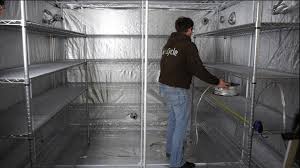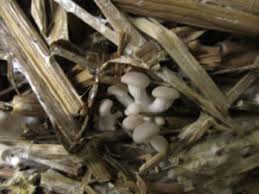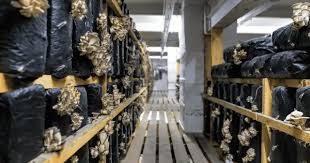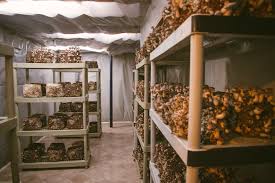Mushroom housing refers to the specialized environments designed for the cultivation of mushrooms, which have gained significant popularity due to their nutritional benefits, culinary versatility, and economic potential.
As urbanization continues to rise and the demand for locally sourced food increases, mushroom housing has emerged as an innovative solution for both commercial growers and home enthusiasts. These controlled environments allow for the efficient production of various mushroom species, including popular varieties such as button, oyster, and shiitake mushrooms.
The concept of mushroom housing is rooted in creating optimal growing conditions that mimic the natural habitat of mushrooms. Factors such as temperature, humidity, light, and ventilation are carefully controlled to ensure maximum yield and quality.
This precision agriculture approach not only enhances productivity but also minimizes the risk of contamination and disease, which can devastate mushroom crops. In addition, mushroom housing can be designed to fit various scales of production, ranging from small, backyard setups to large commercial farms.
In recent years, there has been a growing interest in sustainable agriculture practices, and mushroom housing aligns well with this trend. Mushrooms can be grown on various agricultural byproducts, such as straw, sawdust, and coffee grounds, making them an excellent choice for reducing waste and promoting resource efficiency.
Moreover, mushrooms have a unique ability to break down complex organic materials, contributing to soil health and enhancing biodiversity. This eco-friendly aspect of mushroom cultivation appeals to both consumers and growers who are increasingly aware of environmental sustainability.
The economic potential of mushroom housing is another key driver behind its popularity. As people seek alternative sources of income, mushroom farming presents an attractive option due to its relatively low startup costs and quick return on investment.
Mushrooms can be cultivated in various spaces, including basements, garages, and dedicated growing facilities, making them accessible to a wide range of aspiring farmers. Furthermore, with the rising interest in plant-based diets and functional foods, the market for mushrooms is expanding, offering growers ample opportunities to capitalize on this trend.
For home growers, mushroom housing provides an exciting way to engage in agriculture and enjoy the fruits of their labor. Setting up a small-scale mushroom growing system can be a rewarding hobby that not only yields fresh produce but also serves as an educational experience.
Home cultivation kits are readily available, making it easy for beginners to start their mushroom-growing journey without requiring advanced knowledge or skills. These kits often come with everything needed to get started, from spores to growing substrates, making the process accessible to anyone interested in exploring this fascinating world.
Types of Mushroom Housing

1. Simple Shelters: Basic structures often made of wood or metal, providing minimal protection from the elements. Suitable for small-scale growers.
2. Controlled Environment Chambers: Advanced systems with climate control features such as temperature, humidity, and ventilation. Ideal for commercial mushroom production.
3. Greenhouses: Enclosed structures that utilize natural light and can be equipped with additional heating and cooling systems. Effective for growing mushrooms in a semi-controlled environment.
4. Shipping Containers: Repurposed containers that can be insulated and equipped with climate control systems. Convenient for urban farming and small-scale production.
5. Indoor Grow Rooms: Dedicated spaces within buildings, equipped with proper lighting, humidity, and temperature controls, allowing year-round cultivation.
Benefits of Mushroom Housing
1. Optimal Growth Conditions: Provides a controlled environment that promotes healthy mushroom growth and high yields.
2. Protection from Pests and Diseases: Reduces exposure to contaminants, pests, and diseases, enhancing overall crop quality.
3. Efficient Resource Use: Allows for precise management of water, nutrients, and energy, leading to more sustainable production practices.
4. Extended Growing Season: Enables year-round cultivation, increasing productivity and profitability for growers.
5. Easier Harvesting and Processing: Well-designed housing makes it easier to harvest and process mushrooms, reducing labor costs.
Design Considerations for Mushroom Housing
1. Climate Control: Incorporate systems for managing temperature, humidity, and ventilation to create an ideal growing environment.
2. Space Utilization: Design the layout to maximize space for growing, harvesting, and storing mushrooms efficiently.
3. Accessibility: Ensure easy access for workers to maintain, harvest, and monitor the mushrooms regularly.
4. Sustainability: Consider using eco-friendly materials and renewable energy sources to reduce environmental impact.
5. Scalability: Design the housing to accommodate future expansion as production needs grow.
Read Also: 7 Medicinal Health Benefits of Daffodils (Narcissus Plant)
Materials Used in Mushroom Housing

1. Wood: Commonly used for constructing simple shelters and shelving units due to its availability and ease of use.
2. Metal: Used in commercial structures for durability and strength, especially in controlled environment chambers.
3. Plastic: Often used for insulation and covering in greenhouses, providing flexibility and protection from UV rays.
4. Insulation Materials: Such as foam or fiberglass, help maintain stable temperatures inside the housing.
5. Polycarbonate Panels: Used for greenhouse walls and roofs, allowing light transmission while providing insulation.
Temperature and Humidity Control
1. Optimal Temperature Range: Most mushrooms thrive in temperatures between 60°F and 75°F (15°C to 24°C). Specific requirements may vary based on the mushroom species.
2. Humidity Levels: High humidity (generally between 80% and 95%) is essential for mushroom growth to prevent drying out. Maintaining the right humidity levels is crucial for fruiting.
3. Control Systems: Use thermostats and hygrometers to monitor and maintain temperature and humidity. Automated systems can adjust conditions as needed.
4. Heating and Cooling: Incorporate heaters or air conditioning units for temperature control, especially in regions with extreme weather conditions.
5. Misting Systems: Implement misting systems or humidifiers to maintain adequate humidity levels, particularly during the fruiting stage.
Ventilation Requirements for Mushroom Housing
1. Airflow Needs: Proper ventilation is vital to ensure fresh air circulation and remove excess carbon dioxide produced during mushroom growth.
2. Air Exchange: Aim for regular air exchange (about 1-3 times per hour), depending on the scale of production and type of mushroom.
3. Exhaust Fans: Install exhaust fans to help regulate air quality and temperature, preventing overheating and maintaining humidity.
4. Inlet Openings: Design mushroom housing with inlet openings to allow fresh air to enter while ensuring a proper flow throughout the space.
5. Negative Pressure Systems: Consider using negative pressure systems to enhance airflow, helping to control airborne contaminants and maintain a clean growing environment.
Lighting in Mushroom Housing
1. Natural Light: While most mushrooms don’t require light to grow, some species benefit from indirect light during the fruiting stage. Use translucent materials for greenhouse roofs to allow natural light in.
2. Artificial Lighting: For indoor grow rooms, use fluorescent or LED lights on a timer to provide light for about 12 hours a day, especially during the fruiting phase.
3. Light Intensity: Ensure that light intensity is low to moderate, as excessive light can negatively impact mushroom development.
4. Color Spectrum: Use lights that provide a balanced color spectrum, which can promote better growth and fruiting.
5. Darkness Requirements: Ensure complete darkness during the incubation phase, as many mushrooms require dark conditions for optimal growth.
Read Also: Pests of Stored Products and Damages Caused
Setting Up a Mushroom House

1. Location Selection: Choose a site with good drainage, protection from direct sunlight, and easy access to water and utilities.
2. Structure Design: Build a structure that meets the specific needs of the mushrooms you plan to cultivate, considering size, shape, and materials used.
3. Insulation and Weatherproofing: Properly insulate the mushroom house to maintain stable temperatures and humidity levels while weatherproofing it to protect from outside elements.
4. Install Equipment: Set up heating, cooling, humidity control systems, and ventilation fans as required. Include shelving or racking systems to optimize space for growing.
5. Testing Conditions: Before introducing the mushroom substrate, test and adjust temperature, humidity, and ventilation to ensure optimal growing conditions.
6. Prepare Substrate: Create or purchase suitable substrate for the mushrooms you intend to grow, ensuring it is properly sterilized to prevent contamination.
7. Monitor and Adjust: Once set up, continuously monitor the environment and make adjustments as necessary to maintain ideal conditions for growth.
Maintenance of Mushroom Housing
1. Regular Cleaning: Clean the mushroom house regularly to prevent contamination from mold, bacteria, and pests. Use non-toxic cleaning agents to ensure safety.
2. Temperature and Humidity Checks: Continuously monitor and adjust temperature and humidity levels using thermostats and hygrometers. Regular checks help maintain optimal growing conditions.
3. Ventilation Maintenance: Inspect and clean ventilation systems, including fans and filters, to ensure proper airflow and prevent the buildup of harmful gases.
4. Equipment Functionality: Regularly test and maintain heating, cooling, and humidity control equipment to ensure they operate efficiently and effectively.
5. Pest Control: Implement integrated pest management (IPM) strategies to keep pests under control. Regularly inspect the housing for signs of infestations and take prompt action if necessary.
Common Challenges in Mushroom Housing
1. Contamination: Fungal or bacterial contamination can occur due to improper sterilization of substrates or inadequate cleanliness. This can severely affect yield and quality.
2. Temperature Fluctuations: Extreme temperature changes can stress mushrooms, leading to poor growth or fruiting. Maintaining consistent conditions is crucial.
3. Humidity Control: Difficulty in maintaining optimal humidity levels can lead to dehydration or overly moist conditions, both of which can hinder mushroom development.
4. Pest Infestations: Insects or rodents can invade mushroom housing, causing damage to the crops and introducing diseases.
5. Insufficient Ventilation: Poor airflow can lead to excess carbon dioxide buildup and low oxygen levels, negatively impacting mushroom growth and health.
Safety Considerations for Mushroom Housing
1. Personal Protective Equipment (PPE): Workers should wear appropriate PPE such as gloves, masks, and goggles to protect against spores, contaminants, and chemicals during handling.
2. Fire Safety: Install fire extinguishers and smoke detectors in the mushroom house, especially if using heating equipment. Follow fire safety regulations to minimize risks.
3. Chemical Handling: Safely store and handle any chemicals used for cleaning or pest control. Follow safety data sheets (SDS) and wear appropriate protective gear.
4. Proper Ventilation: Ensure adequate ventilation to prevent the buildup of harmful gases and maintain a safe working environment for all personnel.
5. Emergency Procedures: Establish emergency procedures for dealing with contamination, pest infestations, or equipment failures. Train staff on these protocols to ensure a quick and efficient response.
Read Also: Relationship Marketing Process and Approaches to the Study of Marketing

